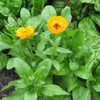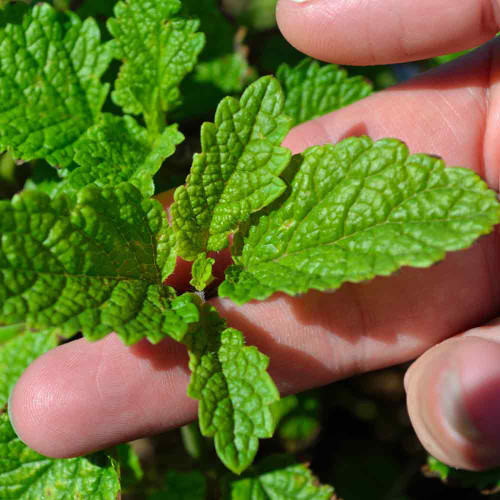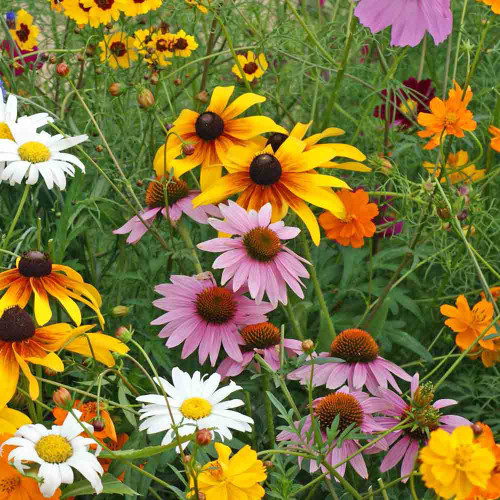Description
Pot Marigold – A Sprinkle of Flavor, A Touch of Healing, A Soil Helper
This cheerful member of the daisy family boasts a sunny personality with a gentle charm, backed by a surprising range of talents. Instead of fluffy blossoms, picture a sunny, delicate, single daisy with a splash of warmth at its center in shades of yellow and orange – that's closer to the Pot Marigold's style.
While it shares the "marigold" name, its old-fashioned cottage garden vibes are far from its cousins' showy, sometimes pungent, blooms. Its gentle looks are deceiving – this little workhorse is packed with practical uses from your garden to your kitchen.
From adding a peppery, tangy bite to salads to soothing skin irritations and protecting your other plants, this marigold, or Calendula officinalis, has more up its sleeve than just good looks. In fact, throughout history, Calendula was known for its healing powers.
It symbolizes warmth, optimism, and new beginnings—a burst of sunshine in your garden! Calendula blossoms follow the sun like tiny sunflowers. This is a truly special blossom with a fascinating story waiting to be discovered.
Details
The cheerful, hardworking calendula plant adds charm wherever it grows. It forms a bushy, compact mound of vibrant color, making it incredibly versatile. Tuck this adaptable beauty along your garden beds, edge garden paths with it, let it spill out of a container, or even squeeze it in among your vegetables for bursts of color and beneficial support.
Plants will be continuously covered in blooms throughout the season, reaching about 1 to 2 feet in height and spread. Dainty, daisy-like flowers in a whole spectrum of warm hues, from soft yellows to vibrant oranges, are a study in sunny delight.
The leaves add another soft, slightly fuzzy layer, releasing a fresh green scent when you brush past them—gently reminding you that they are working hard behind the scenes. The flowers track the sun during the day and close up tight as the sun sets, opening again with the morning light.
History
Pot Marigold's story stretches back centuries, beginning in the sunny Mediterranean landscapes. Ancient Egyptians revered this flower, believing it held rejuvenating powers. They used it as medicine and found its vibrant petals a perfect source of color for cosmetics. Ever practical, the Romans discovered Calendula's hidden talent as a brilliant dye, creating those rich yellows and oranges that became synonymous with their era.
Evidence of its use can be found in ancient Greek and Roman writings. Dioscorides, the respected Greek physician, wrote about a plant in his influential work De Materia Medica, which scholars believe likely describes Calendula. The famous Roman naturalist Pliny the Elder also mentions a remarkably similar plant, noting its use as a vibrant dye and a flavorful addition to meals. These writings offer glimpses into how this versatile flower was valued in the ancient world.
During Medieval times, Pot Marigolds became a staple in European monastery gardens. They were valued for their beauty and wide range of uses—from brightening simple meals to their traditional role in treating minor wounds and skin ailments. Whether named Pot Marigold or Calendula officinalis, this flower has been a cherished companion through the ages.
While its exact ancestry is a bit hazy, the variety we grow today continues the spirit of those old-fashioned, heirloom Pot Marigolds that gardeners have treasured for generations.
Uses
Garden Gourmet: Pot Marigold adds a sprinkle of sunshine to your plate. The star of the kitchen show is its edible flower petals, boasting a mild, peppery, and slightly tangy flavor. Sprinkle them on salads for a cheerful splash of color, stir them into creamy soups, or add them to herb butter for a vibrant spread. Infuse the petals in a simple syrup to add a hint of sunshine and floral sweetness to drinks or desserts.
Nature's Little Helper: This humble flower is more than a pretty face; it's a tireless helper that packs a powerful punch in your garden. The bright blooms attract pollinators like bees, butterflies, and other beneficial insects, who will flock to them, boosting the health of your entire garden.
Plus, many pesky bugs find the scent of this plant unappealing, creating a natural shield around your beloved vegetables. As an added bonus, Pot Marigold's roots loosen heavy clay soil, improving conditions and making life easier for its plant neighbors.
Preserving the Sunshine: Don't let those cheerful blooms fade with the seasons! Dry those vibrant petals for colorful additions to potpourris, or steep them to make gentle, soothing herbal infusions. It's like capturing a bit of summer to enjoy all year round.
Companion Planting
Beneficial companions include beans, tomatoes, and squash—it helps protect them from harmful beetles and pest nematodes. Planting calendula can help control earwigs, as the tachinid fly, a predator of earwigs, can be encouraged by growing dill, fennel, calendula, and alyssum.
Antagonistic plantings include radishes or lettuce.
Pest and Disease Management
Slugs and aphids are two common pot marigold pests.
Aphids are sap-sucking insects attracted to the plant's tender new growth. Look for clusters of these small, soft-bodied pests on the undersides of leaves, along the stems, and even clinging to delicate flower buds. They come in various colors, including green, black, and brown. Keep an eye out for telltale signs like sticky residue (honeydew) or curled and distorted leaves— a sure sign that aphids have been feasting.
Slugs are nocturnal and prefer moist environments. They eat irregular holes in the leaves, leaving telltale slimy edges. They also love the delicate flower petals. The best way to track these pests is to look for new damage appearing overnight with their signature silvery slime trails on and around the plant.
Solutions include blasting aphids off with a strong stream of water, or handpick the slugs. Diatomaceous earth is your secret weapon – this natural powder works wonders against soft-bodied insects. For stubborn infestations, try insecticidal soap. Bring in reinforcements by planting flowers that attract beneficial insects like ladybugs – they'll happily feast on those pesky aphids!
Planting and Growing Tips
Pot Marigolds are remarkably easygoing – start with well-drained soil – they dislike soggy roots. While they appreciate fertile ground, they don't need it to be overly rich. Sunshine is their best friend, so full-sun locations are ideal. However, it is adaptable and will still bloom cheerfully, even with some afternoon shade. When planting, give each Pot Marigold about 12 inches of space to spread out comfortably. You can sow seed directly in the garden after the last frost or get a jumpstart by starting them indoors 4-6 weeks before the warm weather arrives.
Harvest Tips
Harvest your calendula flowers in mid-morning once the dew has dried and the blossoms are fully open—but before the day's heat sets in for the freshest, most vibrant blooms. Pot Marigolds are prolific bloomers, so expect a long season of color starting in early summer and lasting until the first frost. Regularly harvesting the flower heads actually encourages the plant to produce even more, so don't be shy about filling your vases and adding those petals to your salads!
From the soil to the seed to the food you eat - we'll help you grow your best garden!
2 Reviews
-
Best Calendula to grow
I know a lot of people who grow calendula, and really after the first blooms theirs looks like a weed. Not so with this perfect heirloom. Beautiful from the start to finish of the season.
-
Extremely Prolific
I grew this so I can try my hand at making my own skin care products. I started out with several seedlings but only 2 survived. They do start easily. All I needed were those 2 plants as they are very large and bloomed from July until the very end of October and now I have plenty of dried blooms. They are very cold hardy, even after I stopped watering they continued to bloom and went through at least 2 frosts without being covered. Just as a flower they are very pretty but nothing about them looks like a marigold so there is no mixing them up. They also attract a variety of insects. I grew these in my veg garden and occasionally had to tie them up when they tried to overgrow their neighbors. A new favorite for me.

















